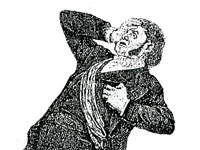Making a Place
A committed group of visionaries is working to revitalize
Homestead’s commercial district.
Fall 2010
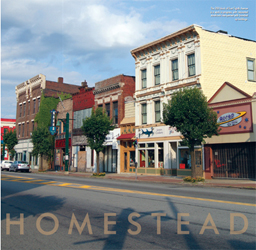
THERE IS NOW A WHOLE GENERATION THAT KNOWS THE 256-ACRE former site of U.S. Steel’s Homestead Works only as The Waterfront—nearly 1.4 million square feet of seemingly endless shopping, dining, and entertainment, extending as far as the eye can see. And so to them (and let’s face it, to most of us), Homestead is The Waterfront.
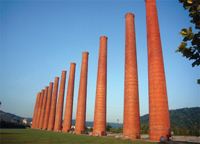
But what has been forgotten is that for the past 105 years, there has existed a town—a town called Homestead—born and raised from the backbreaking labor of generation after generation of gritty steel workers.
Right: Twelve smokestacks, remnants of the U.S. Steel Homestead Works that closed in 1987, serve as a reminder to visitors to The Waterfront of the massive steel mill that once formed the economic base of Homestead.
Below: This postcard, likely from the 1920s, depicts the 200 block of East Eighth Avenue in its earliest heyday. The light-colored building that now houses Annex Cookery and the Tin Front Café is easily identifiable on the right side of the street.
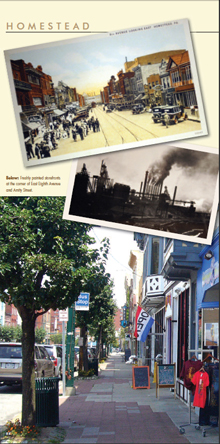

“The steel mill was a 24-hours-a-day, 7-days-a-week, 365-days-ayear operation, and life existed in three shifts,” says Ron Baraff, director of museum collections and archives for Rivers of Steel National Heritage Area, aHomestead-based historic preservation organization. “So with the bars and restaurants open all the time, the main street of East Eighth Avenue was literally double-, triple-parked.”
It’s been decades since the mills shut down, sapping Homestead’s energy. To East Enders coming across the Homestead Grays Bridge and turning left onto East Eighth Avenue headed toward Kennywood, the community may look downtrodden, with storefronts bleak and boarded up in spots. Yet thanks to a committed group of citizens, Homestead—now a borough instead of a town— is beginning to be preserved and revitalized.
One of those citizens is renowned architect and urban designer David Lewis, who holds court at his kitchen table while taking afternoon tea. Spreading his homemade strawberry jam on toasted homemade wheat bread, the native South African speaks passionately about preserving the “experienced buildings” we have inherited.
“These buildings are living just like you are living,” he says. “They talk to me and they have a past, but they also have a future, so we create their future based on what they are now. These buildings have their lives in front of them.
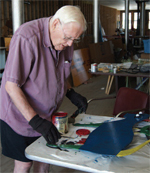
Above: Freshly painted storefronts at the corner of East Eighth Avenue and Amity Street.
“I want to create a street of restored buildings, wonderful shops, and art,” says David Lewis (right), who has been creating metal sculptures (below) to adorn his storefronts and others nearby.

“When you walk down the street, look at the details, look at the brickwork,” he whispers. “Look at the eaves, look at the casements and the windows, and you’ll say, ‘Oh my God.’”
As chairman of the International emaking Cities Conference in 1988, Lewis persuaded HRH The Prince of Wales to participate. When Prince Charles came to Pittsburgh, they toured the Mon Valley together to witness the aftermath of the steel industry’s collapse and to devise solutions for breathing new life into struggling riverfront economies across the United States and Europe.

Right: The Tin Front Café offers breakfast, lunch, and dinner, and a daily happy hour at its aptly-designed bar.
With a total commitment to this end, Lewis, now distinguished professor emeritus of architecture and urban design at Carnegie Mellon University, moved from Oakland and bought a home in neighboring West Homestead. “My experience in urban design has taught me over and over again that it takes a long time for a new development in cities to actually take root,” he says. “And so I decided that I would come over here and be here to work with the community to revive its economy.”

Lewis and his wife, JudiTener-Lewis, have purchased five historic buildings so far, one of them being the Five and Ten Building on East Eighth Avenue, for which Tener-Lewis’ son, Daniel Steinitz, acted as the general contractor for the conversion to four lofts. Another is the Tin Front Building across the street.With two loft apartments above, the Tin Front Café sits at street level and is run by Tener-Lewis’ daughter-in-law, Ellie Gumlock, with help from her brother-in-law, David Tener.
In deciding to open a cafe at this location, Gumlock says she was looking for a use that would become indispensable to the neighborhood and improve quality of life there. With experience in menu design, cooking, and bartending, she says, “I was really excited to have a place of my own where I could just let loose.”
Left:The Tin Front Building as it appeared when Judi and David Lewis acquired it. The ornate façade, which has now been fully restored, is made of pressed tin.
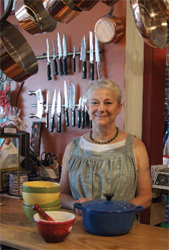
Along with espresso drinks, sandwiches, and salads, the most popular items on the menu at the Tin Front Café are Gumlock’s four-bean chili, spinach and Gruyère quiche, and butternut squash lasagna—best served with a Pinot Evil Pinot Noir or one of 25 Pennsylvania microbrews available.
Connected to the café is the Annex Cookery run by Tener-Lewis. Transplanted fromWalnut Street in Shadyside, the store features the same high-quality cookware, appliances, cutlery, and tableware that her loyal customers have come to expect during the past 43 years. With a proven clientele, the Annex Cookery functions as an anchor store for the 100- to 300-blocks, serving as an attraction for those who might already be shopping at The Waterfront.
“People have had to get used to coming over here to Homestead,” says Tener-Lewis, comparing the trip to setting out for a destination like the South Side or to a shop in Lawrenceville. “You know TheWaterfront has been very successful, but for some reason, people have a strange feeling about coming up to Eighth Avenue, and I think it’s because it has been run down. You know, there’s no doubt.
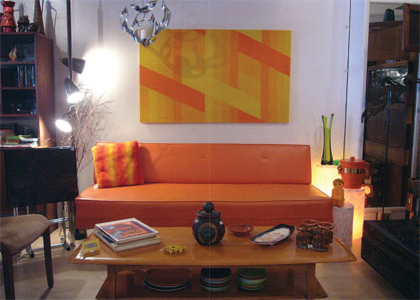
Above: Judi Tener-Lewis at the counter of her Annex Cookery.
Left: Furnishings right out of Mad Men can be found at Retro on 8th
“But now people are very, very happy about Homestead coming back because they remember the day when it was so vibrant.”
Not everyone is as hopeful.
Stanley Levine is a Squirrel Hill resident, who at 82, has worked for 60 years at Levine Brothers hardware store in Homestead. He remembers the glory days when East Eighth Avenue was jumping on Saturday nights. Levine has borne the brunt of competition from Home Depot and Lowe’s and has adapted by becoming more of a service center for fixing lawn mowers, snow blowers, windows, and screens. “Well, I don’t want to put a wet blanket on some of these things, and I wish my friends David and Judi well,” he says. “But I don’t share their enthusiasm or optimism.”
A decade ago, Hayley Kile might have agreed when she purchased her building at a sheriff ’s sale and opened Retro on 8th two years later. “There was absolutely nothing happening on the street,” Kile recalls. “David Lewis hadn’t opened anything yet, and I remember there being no electricity—just a kerosene heater in the center of the building.”
Now, with three vintage shops on East Eighth alone, Homestead may well become the city’s go-to district for retro shopping.
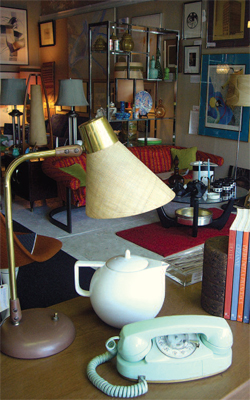
Kile, who works at K&L Gates, and her partner, Jennifer Horovitz, a letter carrier for the U.S. Postal Service, sell mid-century modern furniture, accessories, housewares, and mod dresses from the ’60s, among much more. “I grew up in the ’70s and just love the furniture and the fact that people were into entertaining and not playing PlayStation or on their cell phones,” Kile says.
Since opening her store, Kile has noticed a significant increase in activity on the street. “People are starting to live here,” she says. “People are starting to venture over from The Waterfront.”
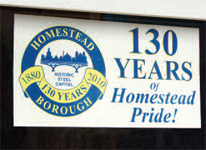
Just a few doors down, BernieSchilling and Drew Knapton, co-owners of Mostly Mod,have just renewed their lease.Schilling is a professional photographer who began collecting retro furniture, art, and accessories reflective of the art deco, mod, and pop eras when he needed props. Looking to move their small store last year from Verona, they found rental rates in Homestead to be lower than Bloomfield and the South Side—and a fraction of Shadyside.
Right: A sign in the window of Homestead Appliances, one of the
businesses on the 200 block of Eighth Avenue, touts the history of Homestead.
Left: The owners of Mostly Mod moved their retro furniture store to Homestead from Verona last year to take advantage of the lower rents.
Schilling advises, “For anybody wanting to open a store or restaurant, now is really the time to get in and lock in a low rental rate before things do start picking up.”
Rounding out this little enclave of vintage shops—next door to Swagger World—is Iron City Vintage, which opened in July on the corner of East Eighth and Amity Street, the former home of Moxley’s Pharmacy. As a standup comic at the Improv at The Waterfront, John Evans is new to retail, but figures that selling, instead of collecting vintage home furnishings, electronics, record players, transistor radios, and such will help himavoid an appearance on Hoarders. “I am really excited to be here because I see the potential traffic going to TheWaterfront,” Evans says. “As a destination for vintage collectibles, we are now giving them a reason to stop.”
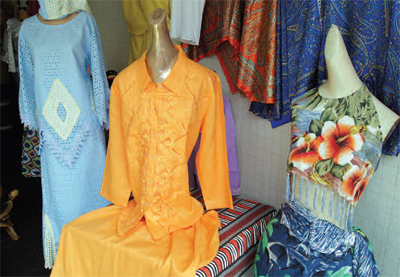
Across the street is Tracy’s Place, selling new and secondhand clothing. “I have everything, including wedding gowns, boots, fur coats, tennis shoes, sunglasses, custom t-shirts, Steelers apparel, you name it—and this is purse heaven,” says owner Tracy Holt, who opened three years ago and also puts on fashion shows for fundraisers.
Just a few storefronts from Tracy’s Place is Blemah Doo’s, a specialty shop for African groceries and clothing. A graduate of the Clarissa School of Fashion Design in Pittsburgh, Dosina “Dee” Blemahdoo says people find her by word of mouth. “When they want something for a special occasion, they come to me,” says Blemahdoo, who custom-makes women’s formal dresses, bridesmaid dresses, and formal men’s African wear from beautiful fabrics sourced across the world.

Like Blemah Doo’s, ventures with the best chance of surviving in Homestead are those that do not compete directly with stores at The Waterfront—like Katie’s Kandy on Amity Street. In full display are colorful penny candy, bulk chocolate, sugar-free candy, gummy candy, Hershey’s ice cream, stuffed piñatas, Mylar helium balloons, and every imaginable kind of candy bar.
“People who walk in are reminded ofWilly Wonka & the Chocolate Factory,” employee Brittany Kennedy says. “Young and old come here, but the older people surprise me the most because they go crazy, just like kids in a
candy store.”
Left: A colorful assortment of candy lines the wall at Katie’s
Kandy on Amity Street.
Joe Ranii hopes more unique enterprises will be attracted to the borough. “All of these shops help to give the avenues their flavor,” says Ranii, owner of Homestead-based Cityscape Construction, which rehabs historic buildings. “And so we are just developing our niche, more or less. What we are looking for are urban pioneers with interesting, edgy products who want a place where their talent and individuality will have all the attention.”
Fitting the bill are Jeff Petruso and Nelda Carranco, who are renting the ground floor of Ranii’s newly renovated 1917 historic Walton And then there are the 40,000 or so cars filled with potential customers headed to The
Waterfront each day. “I only want 50 or so to stop by our place,” he says, smiling. “That’s all I need.”
An already established eatery is Blue Dust, slang for a steel byproduct that ends up on steelworkers’ clothing. The trendy restaurant sits on the corner of East Sixth Avenue and Amity Street, just before the railroad tracks on the approach to The Waterfront. The experienced proprietors of this “gastropub” are Jerry Miller and his daughter, Sarah Cunniff, the kitchen manager.
Hotel building to open a 35-seat restaurant this fall—with a potential microbrewery to come.The barbecue taqueria (Spanish for taco shop) called Smoke will serve breakfast and lunch, featuring signature dishes like smoked pulled pork tacos with avocado crema slaw, caramelized onions, and habanero apricot sauce.
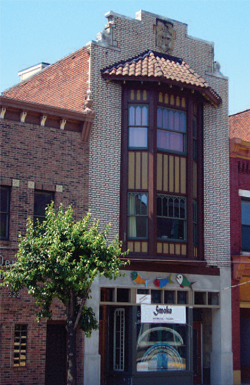
Petruso appreciates the blend of old and new in Homestead. “There is a value here that you just can’t create in another area,” he says.
Recommended are the beer-battered fried zucchini and Homestead surf and turf—a half crabmeat, half beef brisket sandwich. There’s a full bar with 26 different microbrews on tap, so if it’s hard to decide what to imbibe, perhaps try the horseradish-infused vodka or Jerry’s Bloody Mary. If you are still thirsty upon departure, they will happily show you to the eight-door beer cooler for takeout.
Mike Stout, majority owner of Steel Valley Printers, hopes the momentum for Homestead’s revitalization will spread to the 100-block of East Eighth Avenue, where his business is located. He envisions transforming the abandoned lots into a green zone with community gardens and a farmer’s market.
“Homestead has been quite a success story, but it’s far from finished,” says Urban Design Ventures presidentWaltHaglund, whomoved the offices of his planning consulting firm from Shadyside to Homestead in 2005. Haglund says vacancies have dropped significantly since then in the 100, 200, and 300 blocks of East Eighth.
He and his son, Karl, put together the feasibility study and assembled the financing for the $4.7 million conversion of the Homestead Bakery Building on East Seventh Avenue into 16 lofts and commercial space, a development led by Pittsburgh Steelers quarterback Charlie Batch.

Above: Contractor Joe Ranii renovated the 1917 Walton Hotel and operates the architectural salvage business Ancient Ruins on its lower level. On the ground floor, Smoke Restaurant is slated to open soon, specializing in barbeque.
Left: At the Blue Dust bar and eatery on Amity Street, a mural of the Homestead Works steel mill dominates the back wall.
“Charlie has had a tremendous impact on Homestead,” says his mother, Lynn Batch- Settles, who was born and raised in the borough and is the daughter of a 40-year veteran of the mill. “And I can honestly tell you that the day he was drafted by Detroit, I put one small thing in his ear: Never forget where you come from. And he never has.”
How true. Winner of numerous community service awards, for the past nine years Batch has sponsored Project C.H.U.C.K— Continuously Helping Uplift Community Kids—a summer basketball program for kids ages 7 to 18 held in the neighborhood at the Charlie Batch 16th Avenue playground.
In 2005, he opened Danylynn’s Barbershop on Amity Street. In a traditional barbershop atmosphere, Mel McGhee offers haircuts for men and women, shampoos, facials, fades, hair coloring, and time-honored
razor shaves. The name of the shop honors Batch’s sister, Danyl Settles, who died at 17. And last summer, his cousin, Brandon
Doswell, opened Swagger World in the 200 block of East Eighth, featuring high-end jeans with brands like True Religion, Crown Holder, and Ed Hardy.
Some view the relationship between Homestead and The Waterfront as being adversarial, but a more accurate description might be symbiotic.
Homestead now receives $550,000 annually in real estate property taxes from The Waterfront. That amount will increase to roughly $3.6 million a year, including Homestead’s portion of Steel Valley School District taxes, when the development’s tax increment financing deal expires in five years.
“That is the future right there, so it’s going to take time,” says Homestead Mayor Betty Esper, who started out as a messenger at the mill and worked her way up there over 36 years. “We are seeing progress, little by
little.”
One bright sign of hope: In 2007, Homestead was removed from the state’s Act 47 program for financially distressed communities after 13 years.
“We who live in this town understand it,” Esper says. “People coming through this town see some progress, but they don’t understand exactly how hard everybody’s working to develop this area.”
Indeed, it’s a community effort. “You ask me why I do this, and in a way, I think it’s built into me,” says David Lewis, whose grandfather was a visionary mayor in Cape Town, South Africa. “But it’s not built into me alone. Goodness me. I wouldn’t have gone anywhere. It’s built into all of us. I mean, that’s what Joe is all about, and Judi is all about, and my kids, and Charlie, and Walt, and all of these wonderful people. We are all driving in the same direction.
“We are destination-oriented. We go to places. What we are trying to do is to create a place. That’s all we’re trying to do. Create a place. That’s what we want to do. When you say ‘Boarded up,’ I say ‘Great! Come and open it up.’ You know, put your money where your mouth is.Open it up.Make a place, and you’ll make money. Make a place. That’s all we need to do.”
With many thanks to SHADY AVE magazine for granting me permission to reprint on my website.


